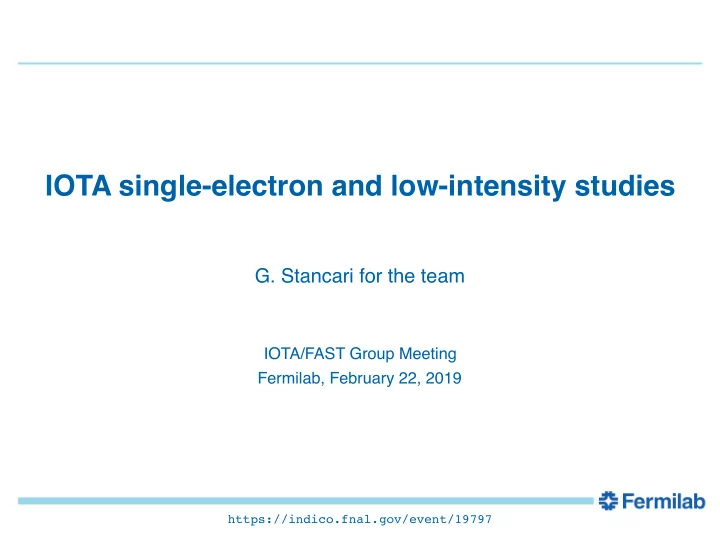

IOTA single-electron and low-intensity studies G. Stancari for the team IOTA/FAST Group Meeting Fermilab, February 22, 2019 https://indico.fnal.gov/event/19797
Study of Thu Feb 21 (8 h) - M3L MCP-PMT signals (MCP out + 4 anodes) are good for timing and position down to ~uA intensities. Sensitivity does not reach single electrons, limited by noise (20 kHz, 400 kHz, 500 kHz, ...). Needs to be investigated and mitigated. Relied mostly on M2R camera intensities. - Collected data on mini-injections repeated every ~60 s. Reliably injected 0 to 3 electrons by inserting screens and regulating laser wave plate. Recorded M2R camera images of 1 stored electron. - Injected ~110 electrons and let intensity decay to study statistics of individual electron loss times and to measure beam lifetime in 10-100 pA range � 2 Giulio Stancari | IOTA low-intensity studies IOTA/FAST Group Meeting | Fermilab, 22 Feb 2019
Photomultiplier signals with 0.48 mA circulating in IOTA M3L MCP-PMT out 20-50 mA noise limits sensitivity (on both Heliax M3L MCP-PMT and RG-58 cables) anode 1 Needs to be filtered or mitigated M2L PMT anode 7.5-MHz marker � 3 Giulio Stancari | IOTA low-intensity studies IOTA/FAST Group Meeting | Fermilab, 22 Feb 2019
Mini-injections Inserted screens in linac, tuned laser wave plate, injected every ~60 s M2R camera intensity [arb. units] 3 e - 2 e - 1 e - 0 e - 0 500 1000 1500 2000 2500 Time [s] Variation on what was done in November (no IOTA injection quad detuning). Shown reliable injection of a few electrons. Also part of our current LDRD on the feasibility of single-electron studies. � 4 Giulio Stancari | IOTA low-intensity studies IOTA/FAST Group Meeting | Fermilab, 22 Feb 2019
Intensity and lifetime measurement down to microamps DCCT Two methods (to assess systematics) (1) Exponential fit M2L PMT (2) Derivative of smooth spline current gain x32 gain x4.5 1 μ A 7.5 MHz M2L PMT counts � 5 Giulio Stancari | IOTA low-intensity studies IOTA/FAST Group Meeting | Fermilab, 22 Feb 2019
Intensity and lifetime in 1-100 pA range (in progress) Two methods (to assess systematics) (1) Exponential fit (2) Max-likelihood fit of intervals between P ( T i ) = λ exp( − λ T i ) individual electron losses (steps) � 6 Giulio Stancari | IOTA low-intensity studies IOTA/FAST Group Meeting | Fermilab, 22 Feb 2019
Beam lifetime vs. intensity IOTA beam lifetime vs. intensity Data of Feb. 14, 2019, 13:30 − 16:02 ● 10 10 ● 8 ● Decay rate [%/min] ● Lifetime [min] 15 N:IBEAM (DCCT) ● ● ● 6 ● N:IBEASL (sync − light PMT) ● ● 20 ● ● ● ● ● ● 4 ● ● 30 ● ● ● ● ● ● ● 45 ● ● 2 ● ● 60 ● 120 0.005 0.010 0.020 0.050 0.100 0.200 0.500 Beam intensity [mA] � 7 Giulio Stancari | IOTA low-intensity studies IOTA/FAST Group Meeting | Fermilab, 22 Feb 2019
Recommend
More recommend